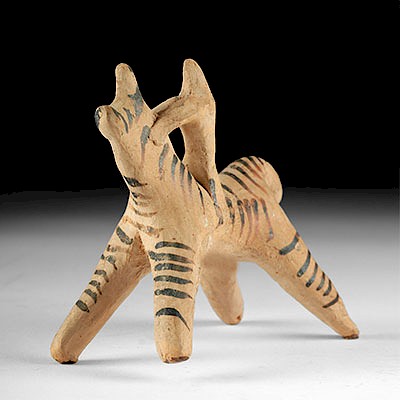Translated Egyptian Terracotta Funerary Cone
Lot 2c
About Seller
Artemis Fine Arts
686 S Taylor Ave, Ste 106
Louisville, CO 80027
United States
Selling antiquities, ancient and ethnographic art online since 1993, Artemis Gallery specializes in Classical Antiquities (Egyptian, Greek, Roman, Near Eastern), Asian, Pre-Columbian, African / Tribal / Oceanographic art. Our extensive inventory includes pottery, stone, metal, wood, glass and textil...Read more
Estimate:
$900 - $1,200
Absentee vs Live bid
Two ways to bid:
- Leave a max absentee bid and the platform will bid on your behalf up to your maximum bid during the live auction.
- Bid live during the auction and your bids will be submitted real-time to the auctioneer.
Bid Increments
| Price | Bid Increment |
|---|---|
| $0 | $25 |
| $300 | $50 |
| $1,000 | $100 |
| $2,000 | $250 |
| $5,000 | $500 |
| $10,000 | $1,000 |
| $20,000 | $2,500 |
| $50,000 | $5,000 |
| $100,000 | $10,000 |
| $200,000 | $20,000 |
About Auction
By Artemis Fine Arts
Oct 25, 2018
Set Reminder
2018-10-25 11:00:00
2018-10-25 11:00:00
America/New_York
Bidsquare
Bidsquare : Antiquities from Egypt, Greece, Italy, Asia
https://www.bidsquare.com/auctions/artemis-gallery/antiquities-from-egypt-greece-italy-asia-3538
Featuring Egyptian, Greek, Roman, Etruscan, Near Eastern, plus Asian art from Central and Far East. If you love the classics, this is the sale for you. Artemis Fine Arts info@artemisgallery.com
Featuring Egyptian, Greek, Roman, Etruscan, Near Eastern, plus Asian art from Central and Far East. If you love the classics, this is the sale for you. Artemis Fine Arts info@artemisgallery.com
- Lot Description
Ancient Egypt, New Kingdom Period, 18th to 20th Dynasty, ca. 1550 to 1070 BCE. A coarse, hand-built terracotta funerary cone with a cylindrical form, a fractured lower body, and a stamped circular face with four columns of hieroglyphic text surrounded by white pigment in low relief for a known personage from the New Kingdom. When translated, the cone reads, "Overseer of the Treasury, Scribe to the King, Diehutynefer." Three small finger indentations are visible near the lower rim. Funerary cones, representing the ends of chapel roof support beams, were traditionally inserted in rows with their flat ends facing outward above the mud-brick entrances of the superstructures of non-royal tombs in Thebes. Made of fired Nile mud, cones like this example are some of our earliest written records. Most are found in the Theban Necropolis in Upper Egypt and the surrounding area, where the tradition seems to have been particularly strong. Size: 3.7" L x 2.6" W x 2.75" H (9.4 cm x 6.6 cm x 7 cm).
This cone is registered in Macadam's "Corpus of Inscribed Egyptian Funerary Cones," Oxford, 1957, no. 176.
Provenance: ex-private Lexington, Kentucky, USA collection; ex-private Los Angeles, California, USA collection; ex-private Ontario, Canada collection; ex-private Mathues collection, USA. The Mathues family is a husband/wife archaeological team that was invited by the Brooklyn Museum to accompany archaeologists on digs in Egypt in the 1960s, and this piece is part of their collection from one such dig.
All items legal to buy/sell under U.S. Statute covering cultural patrimony Code 2600, CHAPTER 14, and are guaranteed to be as described or your money back.
A Certificate of Authenticity will accompany all winning bids.
We ship worldwide and handle all shipping in-house for your convenience.
#139718Lower half missing. Minor nicks to body and both faces, with fading to hieroglyphic text and white pigment. Nice earthen deposits throughout. Hieroglyphic text is still somewhat legible.Condition
- Shipping Info
-
All shipping is handled in-house for your convenience. Your invoice from Artemis Gallery will include shipping calculation instructions. If in doubt, please inquire BEFORE bidding for estimated shipping costs for individual items.
-
- Buyer's Premium



 EUR
EUR CAD
CAD AUD
AUD GBP
GBP MXN
MXN HKD
HKD CNY
CNY MYR
MYR SEK
SEK SGD
SGD CHF
CHF THB
THB














